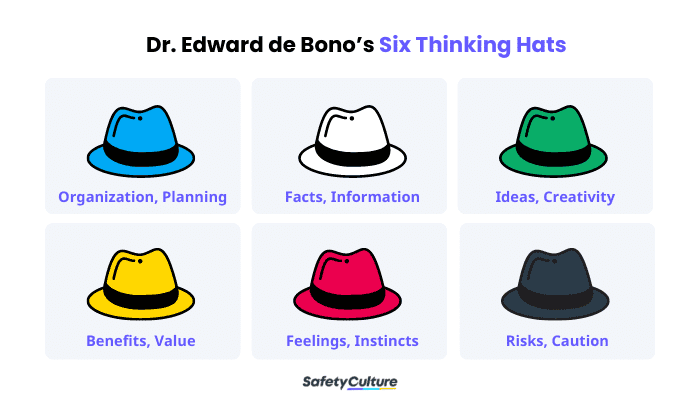What is the Six Thinking Hats Technique?
Used as a comprehensive thinking process method, the concept of the six thinking hats allows teams and individuals to improve their problem-solving and decision-making processes. Ultimately, such a methodology aims to look at situations and problems from various perspectives, ensuring that creativity aids in going beyond the habitual ways of thinking.
In some cases, this technique serves as a powerful lean methodology tool, in such a way that the six hats of thinking process helps eliminate “waste” or unnecessary conflicts and disputes during the discussion. In turn, only clarity and productivity are left in the process.
It’s also crucial to note that this thinking method is inclined toward providing a more positive approach to how teams and individuals propose solutions. This way, conflicts can be reduced and a healthy and sustainable culture of collaboration and cooperation is established.
History
Dr. Edward de Bono, a Maltese physician, psychologist, and philosopher, wrote a book called “Six Thinking Hats” in 1985. As stated on the book’s cover, the simple technique is based on the brain’s various modes of thinking and aims to empower everyone to “run better meetings, make faster decisions.”
Furthermore, Dr. de Bono believes that the central difficulty of thinking boils down to confusion, where people try to do too much all at once. At the core, it’s as if people attempt to juggle too many balls, allowing loads of responsibilities to overwhelm them.
To help contain such a challenge, he describes 6 various types of thinking, with each represented by a unique hat color. This is how the concept of the Six Thinking Hats was born.
Benefits of Six Thinking Hats
As part of any organization’s long-term efforts to establish and sustain quality operations, going back to the basics may be regarded as something that’s too simple. However, that’s where it should start, most especially during discussions where ideas come to life.
Since its inception in 1986, the concept of the six thinking hats has helped organizations worldwide. Now, what are the six benefits of the six thinking hats? Here are the main factors where using this thinking process can be highly beneficial.
Organization
Using the six thinking hats technique promotes a highly organized process of thinking. This is because every angle tends to be considered, which helps further weigh information and remove unnecessary details, promoting streamlined decision-making.
Creativity
With various team members assuming unique yet common roles during the thinking process, they are encouraged to probe situations and suggest ways to address them, going beyond the obvious or basic ways to do so. This, in turn, lets groups and individuals challenge their own capabilities, get more innovative ideas, and combine various perspectives to come up with new ones throughout the process.
Productivity
Since the technique strengthens key skills such as organizational skills and creative thinking, people achieve more in fairly less time. This is because they are more empowered to work together, knowing the supposed direction of the discussion or problem-solving process. Hence, the six thinking hats method promotes role ownership and responsibility.
Quality decision-making
Ensuring that the context of the discussion is well-defined to a group is integral to reducing conflict and encouraging a more proactive way of thinking. One hat at a time, the members of the group can focus on one perspective then move to the next. This leads to quality decisions brought about by the positive impact of the process.
Inclusivity
As the group takes on a role by assuming a common “hat” in the process, any preconceptions may be set aside so that the group can collectively focus on one perspective at a time. With minimal conflict and shared understanding, everyone can feel included in the discussion.
Interpersonal skills
The six thinking hats technique also improves one’s listening and communication skills. Further, using such a methodology helps people become more persuasive as they pitch ideas, more aware of when to support others during the discussion, and more confident with the way they present solutions and resolve conflicts that may occur.
What the Six Thinking Hats Represent
What are the six thinking hats and what do they represent? Let’s go through each of them in detail.

Dr. Edward de Bono’s Six Thinking Hats
1. Blue hat
Responsible for when the group is focused on managing the overall decision-making, the blue hat mode is when the discussion’s agenda and goals are formed.
Sample questions to ask while using the blue hat:
- What needs to be resolved?
- How should we define the problem?
- What are the goals or desired outcomes?
- How will the process of using each hat go?
- What kind of decision shall we arrive at?
2. White hat
Representing the process of gathering information, the white hat doesn’t just tackle the details that are available for the team’s reference, but also identify other pieces of information that are lacking and need to be collected.
Sample questions to ask while using the white hat:
- What data is available?
- What information is required?
- What information is missing?
- What needs to be done to gather such information?
- What questions need to be asked?
3. Green hat
Used to spark novel and creative ideas, “wearing” the green hat allows for a free-flowing, think-outside-the-box process where any idea can be looked into, discussed, and noted.
Sample questions to ask while using the green hat:
- Are there thought experiments we can do?
- Is it possible to explore new ideas or opportunities?
- What are the other options we have to carry this out?
- Are there any other scenarios we can consider based on this idea to come up with new insights?
- What kind of risks are we willing or able to accept?
4. Yellow hat
Typically covering the potential benefits of ideas, the yellow hat allows people to look at issues using the lens of optimism, further probing the insights gained during the green hat process.
Sample questions to ask while using the yellow hat:
- Are there any opportunities for the green hat to expand on to show a clearer way of achieving the desired outcomes?
- How can we lay down the factors that would make this idea beneficial or successful?
- How do we define success?
- How does this idea make our processes better?
- What are the potential long-term benefits?
5. Red hat
Combining instincts and feelings, the people engaged in the red hat type of thinking are free to express their feelings toward the ideas passively, without having to explain or justify their fears or dislikes in a logical way.
Sample questions to ask while using the red hat:
- How do we feel about the possible choices we will make?
- What are our gut feelings about the idea we are proposing?
- What are our initial reactions?
- What kind of emotions does this idea bring out?
- What does our intuition say about the solution?
6. Black hat
Often regarded as the “negative yet logical” type of thinking hat, the black hat aims to represent the act of looking at the possible scenarios that may be far from or opposite to the desired outcome, along with the risks associated with the ideas.
Sample questions to ask while using the black hat:
- What are the possible failure scenarios?
- How do we identify the idea’s fatal flaws?
- What are the potential risks and consequences we are likely to face?
- What are the reasons why we should not proceed?
- What might be the challenges along the way?
Though the six thinking hats process may be tailored-fit to suit the needs of the individual or group using it, knowing its ideal step-by-step method helps direct any meeting, brainstorming, or discussion in a more practical, conflict-free way.
Having that said, what is the order of the six thinking hats? As described by TSW Training, this is the recommended order:
- Blue hat
- White hat
- Green hat
- Yellow hat
- Red hat
- Black hat
It’s best to remember that facilitators or even team members can suggest using a different hat at any point in the discussion that seems more relevant or appropriate.
How to Use This Thinking Process
Dr. Edward de Bono believed that using the six thinking hats method toward success requires intentionally steering the discussion toward a particular approach.
Following the prescribed order of using the six thinking hats by TSW Training, a meeting can begin with all members “wearing” the blue hat to identify how the meeting will go and what the goals and objectives will be. Then, they can all move to the white thinking hat to present the needed information and what steps to take in gathering further details for the agenda. After that, the group can then proceed to “wearing” the green hat to generate ideas and solutions. In relation to this, the yellow hat allows the team to look at the new ideas from a positive viewpoint, laying down the potential benefits they can get from implementation. The next step is to use the red thinking hat to encourage everyone to express their feelings and instincts about the proposed solutions without having to justify what they feel. Lastly, the black hat is worn to challenge such ideas and probe the potential risks and how certain cautionary measures can be set in place in case the solutions fail.
The process of the six thinking hats can also be applied in the workplace, specifically for operations management and the following aspects:
- Leadership development
- Product and process improvement
- Project management
- Team collaboration and alignment
- Organizational system change and performance management
Digitize the way you Work
Empower your team with SafetyCulture to perform checks, train staff, report issues, and automate tasks with our digital platform.
Get Started for Free



